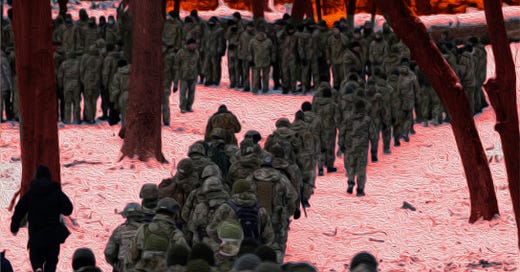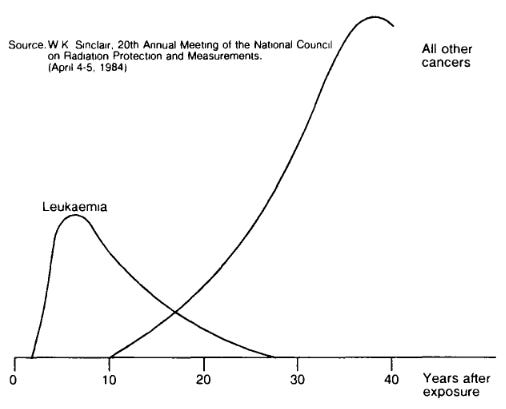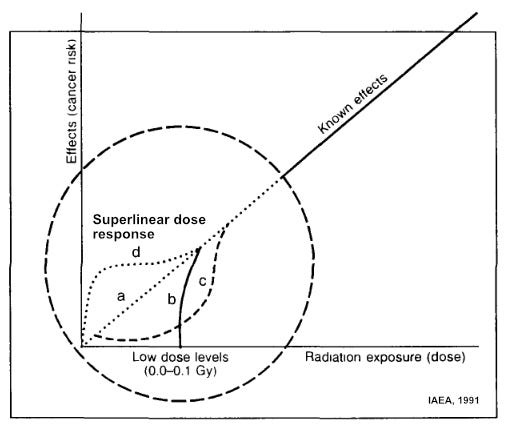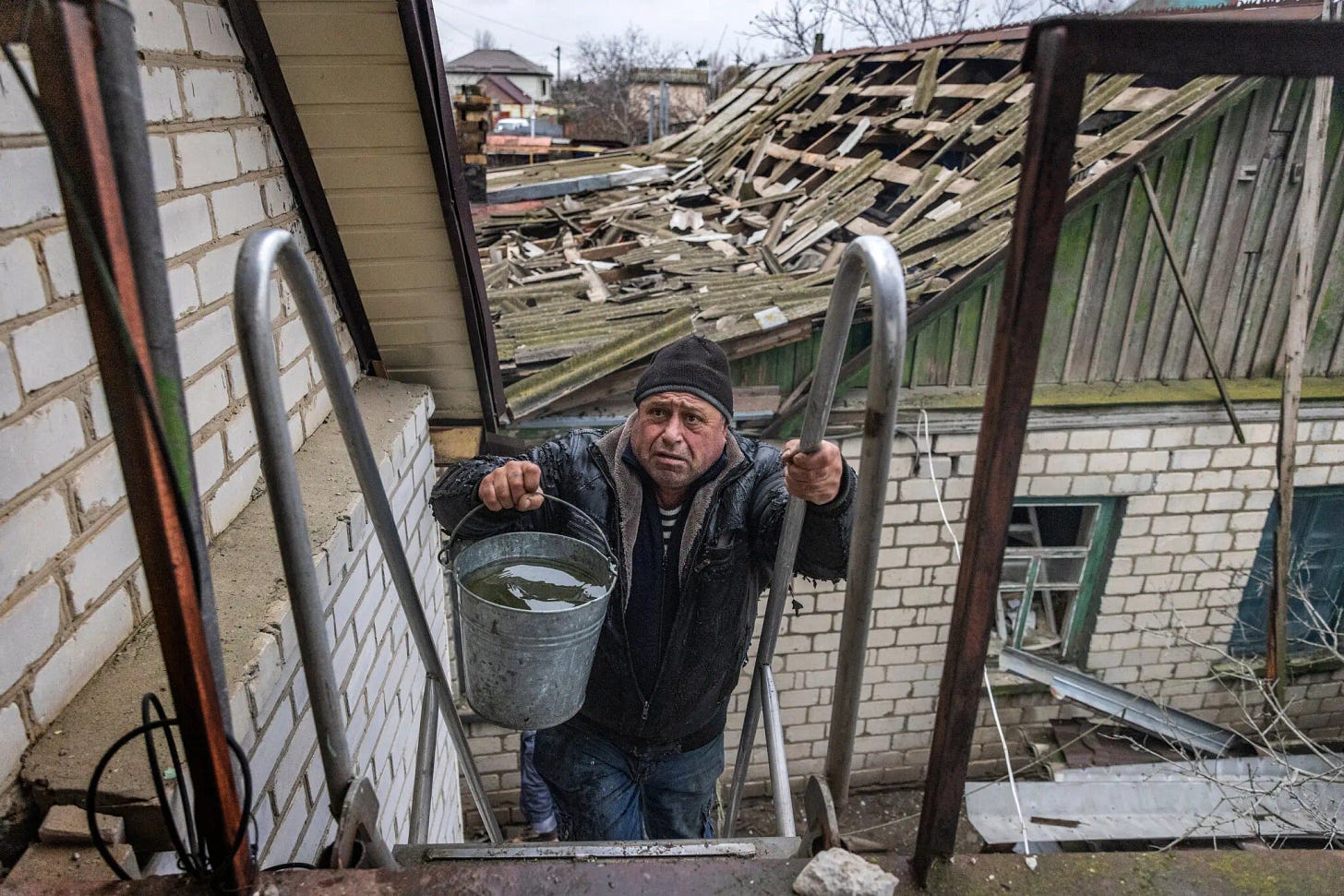Dark Comedy in the Red Forest
The best way to assure history will repeat is to make sure no one can learn from it.
Picture this: a surreal scene straight out of a dark comedy. The Red Army, armed with bulldozers and tanks, digs trenches and sets up shop in the infamous Red Forest near the Chernobyl nuclear site. Yes, you read that right. The very same place where trees turned red, frogs mutated, and feral dogs became wolves again. But here they were, Russian soldiers stationed in the most heavily irradiated site on Earth, apparently oblivious to the health risks they were facing. It's like a twisted episode of a reality TV show where contestants vie for the title of "Most Clueless Commander."
In early February 2022, the US Defense Intelligence Agency shared some satellite images with counterparts in Kyiv. The Red Army was building a pontoon bridge to ford a river running through the Pripyet marshes. Ukraine ignored the intel, saying Russia’s Eastern Military District was just conducting a military exercise called Allied Resolve with Belarussian forces. The Pentagon leaked the images to Twitter in an effort to force Kyiv to pay attention.
By the afternoon of the war’s first day, columns of the 36th Combined Arms Army had crossed that bridge and seized the Chernobyl nuclear site, accepting the surrender of the local National Guard detachment and taking roughly 210 civilian staff, as well as the guardsmen, hostage.
Clueless Commanders
It's mind-boggling how the Russian advance column, supposedly equipped to handle radiation hazards, was utterly ignorant of the dangers they were facing. Troops started experiencing symptoms like vomiting, hair loss and collapse shortly after their arrival. The commanders ordered them to "man up and tough it out” even as green military buses, windows covered, smuggled away the sick to a special rad-safety hospital built to handle the injured in 1986 when Chernobyl suffered a massive explosion with global fallout that contributed in no small way to the collapse of the Soviet Union.
As 30,000 Russian troops drawn from all four armies of Russia’s Eastern Military District poured across that pontoon bridge, the P56 highway running from Chernobyl became a funnel onto one of the main invasion routes to Kyiv. The occupiers dug trenches, foxholes and even an underground bunker network in the very forest where much of the contaminated topsoil and debris from Chernobyl had been buried. Radiation had killed the trees, turned their bark red and spread grotesque mutations among the feral dog populations and frogs, rodents, possums, and birds. Now it did the same to the invading army.
Monitoring stations immediately registered a 20-fold increase in radiation. Reading from official press releases, the well-schooled BBC downplayed the danger, comparing the dose to 5 times what you would get on a transatlantic flight.
If that were not enough, Russia’s Chernobyl garrison was apparently hungry and went hunting and fishing around the Exclusion Zone. Notably, they reportedly fished for catfish—which had multiplied in the reactor’s water-cooling channel—and shot wild animals.
—Popular Mechanics
Russian forces finally pulled out between March 20th and April 1st, trashing and looting the facilities.
After receiving a patient transferred from the Republican Research Center for Radiation Medicine and Human Ecology, Mikalai said that he had been curious about how the hospital was operating. So, late one night, he drove slowly past the complex. “I saw when it started getting dark, military medical buses coming to the hospital … green-colored ‘PAZ’ vehicles, with their windows covered with white cloth,” he said.
— CNN
How could it be that the Red Army commanders were so ignorant of the danger? They seemed to have no notion of what they were dealing with. That, dear readers, is the subject of our ongoing series about the devaluation of truth in the age of social media and artificial intelligence.
In the 1940s and 50s, Colonel Stafford Warren had dubbed the military response to subatomic power “the hairy chested approach,” mocking marine officers who led men from trenches to within yards of Ground Zero during atomic tests in Nevada. Wishing nuclear energy were clean does not make it so.
A Legacy of Premeditated Murders
These recent events brought back memories of the dying radiation victims I've encountered throughout my life—the sailors, the lab techs, the miners, and the workers in nuclear facilities. It's a grim reality that these were not accidents but premeditated murders. The anger I feel lingers, and I speak on behalf of those who have suffered and continue to suffer the consequences of engineered ignorance.
Having sat with grieving families by the bedside of dying radiation victims, I know full well that the Chernobyl encampment was no accident. I speak for Seaman John whose dime-size burns on his calves at Operation Crossroads at Bikini Atoll in 1946 were only amputated with his legs in 1982 after the lymphosarcoma had progressed to all his extremities, eventually claiming his life, as his wife Rose wept on my shoulder.
I speak for Vern, USAF Captain, who could see the bones in his hands as if through a fluoroscope as he piloted his Tennessee Air National Guard sabre jet through a mushroom cloud rising over the Nevada Proving Ground in 1953. He died of leukemia, oozing pale pink blood from every orifice. Thanks to his sacrifice the FAA now instructs all pilots: "If possible, flying through radioactively contaminated air space should be avoided.”
I speak for the downwinders, the lab techs, the Oak Ridge and Hanford production line workers, the Navajo miners, the Marshall Islanders, and now, lately, the unsuspecting Russian infantry and armored divisions ordered to bivouac in the Red Forest, and potentially, everyone in Europe soon to be bathed in fallout if Zaporizhzhia melts down.
These are not accidents. They are premeditated murders.
Some years ago, when the National Association of Atomic Veterans was before the United States Supreme Court challenging a law that prevented veterans from being represented by lawyers in compensation claims, one of our paralegals stumbled upon a remarkable cache of declassified documents at the Bancroft Library at UC-Berkeley.
Col. Stafford Warren may be best known as the guy who invented the mammogram. When he died, his widow donated his papers to the university, not appreciating what all they contained. That collection is now available online in digital form, but soon after we found them, selected parts appeared in our federal court filings. Then FBI agents descended on the library and scrubbed the collection of those portions of greatest interest to history. Gone was a whole middle section of Warren’s illustrious career. He had known too much, and had kept journals.
After his post-doc work on X-rays at the University of Rochester School of Medicine, he answered the call and eventually was commissioned as a colonel and Chief of the Medical Section of the Manhattan Engineering District where he was responsible for the health and safety of the thousands of personnel involved in the Manhattan Project.
Warren worked with the big names: Oppenheimer, Teller, Fermi. He likely did the post-mortem on Louis Slotin who died, horribly, trying to understand the secrets of the Plutonium core. Warren was in charge of health safety at the very first bomb test in Alamogordo, New Mexico. He led the survey team to assess the effects of the atomic bombings of Hiroshima and Nagasaki. In 1946 he was Chief of the Radiological Safety Section of the Joint Task Force for Operation Crossroads at Bikini Atoll. It was his mistake that sent Seaman John’s crew back aboard the USS Nevada to try to scrub the decks and restore power.
The ship can be seen in the often-shown film clip of the Baker test in the stem of the mushroom cloud as a black vertical splotch rising 200 meters into the sky. It then settled back into an upright position like a bathtub rubber ducky, its railings and superstructure melted, bent, and torn but its deck and hull intact.
Lest we forget, Nevada was the only ship to slip anchor and steam away from berth on Battleship Row during the Pearl Harbor attack. Her crackerjack crew engaged the airborne and underwater attackers before beaching near the harbor entrance.
If, having had her bow pointed to zenith by an atomic bomb and then settling back upright, she could be restarted, that would be an amazing recovery—the stuff of legends. It might mean that battleships could fight nuclear engagements and live to fight again.
The Hairy Chested Approach
It was not to be. The bare-chested swabbies fell sick and collapsed even as Warren’s team of moon-suited medics with Geiger counters read no appreciable reduction of the hazard after days of scrubbing. Warren’s journals reveal his heated arguments with Navy brass that far too late pulled the men back off Nevada and let her be scuttled in the lagoon. Some sailors died within weeks. Others suffered for years before passing. Because cancers have minimum latencies depending on site and type—5 years for leukemia and cancers of the bone, 15 years for breast, decades longer for different kinds—victims have similarities but drawing causal associations is difficult to impossible. Lots of things cause cancer, after all.
Cancers are only the tip of a much larger iceberg. Below lurks a much larger cohort of genetic defects that we’ve known since the time of Mullër’s experiments with fruit flies are 100 times greater in number and differentiation. The National Academies of Sciences periodic report on the Biological Effects of Ionizing Radiation (BEIR) lists more than 500 radiation-induced genetic diseases but because a number of those are immune suppressing, the entire panoply of human illness can be caused or aggravated by exposure to ionizing radiation, for generations.
The fetal thyroid begins to accumulate iodine at about 10 weeks of gestational age. Radioactive iodine, strontium, cesium, tritium, carbon and other isotopes easily cross the placental barrier. Even if a fetus survives to term it may be born horribly disfigured, as was seen in Hiroshima, Bikini, after Three Mile Island in livestock, and in the newborns of Fallujah.
The Lurking Danger
Electrons, neutrons and proton pairs thrown off by ionizing radiation break strands of DNA, which can reassemble. At a high enough dose, exposure merely kills the cells. Death is quick. The lurking danger comes from low-dose exposure, where cells survive to reproduce. The lower the dose, the greater the danger of latent effects decades or generations later. A former medical director of Lawrence Livermore Laboratory estimated the meltdown of Three Mile Island shortened the lives of at least one million people. Chernobyl likely killed many times that, as suppressed Russian epidemiological studies show. Susceptibility will vary by race, family histories, and income. The good news? If climate change causes near-term extinction of the human race, most of these deaths may never occur.
Hidden in the Warren papers were the examinations of jellyfish babies in the Marshall Islands following atoll nuclear tests. It is perhaps overly optimistic to imagine that had we all known about those that Fallujah might have been spared the jellyfish babies that followed the US invasion of Iraq when USMC armor went down streets placing Depleted Uranium rounds into each and every building, which turned the sunsets green.
Perhaps the Red Army tank corps would have known better than to entrench themselves in the Red Forest until troops began puking up blood. Such forbidden knowledge might have stopped TVA from dumping its uranium tailings on Edgemont, South Dakota until children who played in the sandpile started showing unexplained bruises, swelling of their extremities, and nosebleeds, followed by an epidemic of leukemia and bone cancers. Maybe Clara Harding would still have her husband Joe, whose plant at Paducah, Kentucky never checked the film badges that uranium process workers were told to wear, as if they magically shielded them from harm.
Nuclear energy supplied ∼11% of global electricity production in 2011. Three countries draw more than half their electricity from nuclear plants (France leads at 78%, followed by Slovakia and Belgium at 54% each), and ten additional countries, all but one in Europe, draw more than 25% from this source. In the United States, 19% of electricity comes from nuclear plants.
***
The largest available study of nuclear power workers (more than 400,000 workers in 15 countries, contributing more than 5 million person-years of observation) found increased risks of solid cancers and leukemia, consistent with prior studies of low-dose radiation health effects.
***
Emissions from reprocessing plants, which are found mostly in France and the United Kingdom, exceed those of power plants by several orders of magnitude.
***
A meta-analysis of 136 nuclear sites in Europe, North America, and Japan found a 5–24% elevation in childhood cancer mortality depending on proximity to nuclear facilities
***
[A German study] found a 60% increase in solid cancer risk and a 120% increase in leukemia risk among young children living within 5 km of German nuclear reactors.
***
The Chernobyl accident resulted in the resettlement of 400,000 people from affected parts of Belarus, Russia, and Ukraine, with enormous social and economic consequences.
***
Cleanup workers demonstrated substantial increases in suicide, suicidal ideation, PTSD, and other psychiatric illnesses, which persisted two decades after the accident. Researchers found that general psychological distress was also common in nuclear plant workers in the months after the Fukushima disaster.
***
The potential for weaponization or terrorist attacks on nuclear fuel cycle facilities, however, pose the most difficult, yet perhaps the largest, risks to quantify and manage.
— Smith, et al, Energy and Human Health
In 1972, the Nuclear Regulatory Commission conceded in a filing published in the Federal Register that the routine operation of entire nuclear fuel cycle, barring accidents, will likely cause some 1.74 million cancer deaths in the civilian population. It justified the cost because it was fewer than die from the coal fuel cycle, the benefits in terms of electricity were great, and individual causality would be impossible to ascribe. The vast majority of those deaths will not be from clean, shiny, well-regulated power plants, but from the dirtier parts of the fuel cycle where Joe Harding worked and the Native American children of Edgemont played.
Warren’s papers remained a secret in plain sight from the time of his death in 1981 to when we discovered them. Once they were known, the cleaners arrived at the library to make them secret again or perhaps even to destroy them permanently.
The best way to assure history will repeat is to make sure no-one can learn from it.
With Cobblepot’s bravura performance at the CNN Town Hall and Ol Joe’s rant on Truth! at his Press Corps roast, the popular media has been clucking all week about the sorry state of public discourse.
Lest we forget, playing with the truth is nothing new. See, for instance, Niccolò di Bernardo dei Machiavelli’s playbook for European sovereigns and their colonial progeny.
The modern-day equivalent of schooling the Viceroy in the proper management of truth is parameterizing the algorithms of artificial intelligence. The analog of a Redcoat midnight knock at the door is the de-platforming, discrediting, or erasure of inconvenient commentators.
A particularly poignant example—one that has already cost millions of innocent lives and is well on its way to many more, barring near-term human extinction—is the engineered illusion that nuclear power is safe.
When it comes to nuclear power, let's not be fooled by the glossy brochures and fancy promises. The health risks are real, the accidents are catastrophic, and the long-term consequences are just too risky to ignore. It's time to embrace a brighter, safer, and more naturally regenerative future. Let's leave the nuclear power plants where they belong: in the realm of dark comedy, not in our backyards.
References:
Baker PJ, Hoel DG. Meta-analysis of standardized incidence and mortality rates of childhood leukaemia in proximity to nuclear facilities. Eur. J. Cancer Care 16: 355–63 (2007)
Bates, Albert K. Shutdown: Nuclear Power on Trial (Summertown: Book Publ. Co 1979)
Bates, Albert K. The Karma of Kerma: Nuclear Wastes and Natural Rights. J. Envtl. L. & Litig. 3: 9 (1988)
Bertell, R. No immediate danger. The radioactive contamination of the earth. Keine akute Gefahr. Die radioaktive Verseuchung der Erde. (Summertown: Book Publ. Co 1987)
Gofman, John W. Radiation and human health, (San Francisco: Sierra Club Books 1981)
Gofman, John W. Radiation-induced cancer from low-dose exposure: an independent analysis. (San Francisco: Committee for Nuclear Responsibility, 1990)
Grosche B, et al. Lung cancer risk among German male uranium miners: a cohort study, 1946–1998. Br. J. Cancer 95:1280–87 (2006)
Kaatsch P, et al. Leukaemia in young children living in the vicinity of German nuclear power plants. Int. J. Cancer 122:721–26 (2008)
Natl. Res. Counc. Coal Waste Impoundments: Risks, Responses, and Alternatives. (Washington, DC: Natl. Acad. Press 2002)
Natl. Res. Counc. Health Risks from Exposure to Low Levels of Ionizing Radiation: BEIR VII Phase 2. (Washington, DC: Natl. Acad. Press 2006)
Nussbaum R. The Chernobyl nuclear catastrophe: unacknowledged health detriment. Environ. Health Perspect. 115: A238–39 (2007)
Petryna A., Life Exposed: Biological Citizens after Chernobyl. (Princeton, NJ: Princeton Univ. Press 2002)
Smith, Kirk R., et al. Energy and human health. Annual Review of public health 34: 159-188. (2013)
von Hippel F, Bunn M, Diakov A, Ding M, Goldston R, et al. Nuclear energy (2012)
Wakeford R. Radiation in the workplace—a review of studies of the risks of occupational exposure to ionizing radiation. J. Radiol. Prot. 29: A61–79, (2009)
Portions of this post were suggested by Chat GPT 4.0
Meanwhile, let’s end this war. Towns, villages, and cities in Ukraine are being bombed every day. Ecovillages and permaculture farms have organized something like an underground railroad to shelter families fleeing the cities, either on a long-term basis or temporarily, as people wait for the best moments to cross the border to a safer place, or to return to their homes if that becomes possible. There are 70 sites in Ukraine and 500 around the region. As you read this, we are sheltering some 2,000 adults and 450 children. We call our project “The Green Road.” With public donations from people like yourself,
88 houses were restored
33 wells were restored
32 wood heating stoves in houses were restored
water was supplied to 34 houses
5008 euros were spent on gardens, orchards, and animals
17,448 euros were spent on food
19,045.70 euros went to household and kitchen items
12,558.80 euros provided schoolbooks, musical instruments and hand tools.
For most of the children refugees, this will be their first experience in ecovillage living. They will directly experience its wonders, skills, and safety. They may never want to go back. Those that do will carry the seeds within them of the better world they glimpsed through the eyes of a child.
Those wishing to make a tax-deductible gift can do so through Global Village Institute by going to http://PayPal.me/greenroad2022 or by directing donations to greenroad@thefarm.org.
There is more info on the Global Village Institute website at https://www.gvix.org/greenroad or read this recent article in Mother Jones. Thank you for your help.
The COVID-19 pandemic destroyed lives, livelihoods, and economies. But it has not slowed climate change, a juggernaut threat to all life, humans included. We had a trial run at emergency problem-solving on a global scale with COVID — and we failed. 6.93 million people, and counting, have died. We ignored well-laid plans to isolate and contact trace early cases; overloaded our ICUs; parked morgue trucks on the streets; incinerated bodies until the smoke obscured our cities as much as the raging wildfires. The modern world took a masterclass in how abysmally, unbelievably, shockingly bad we could fail, despite our amazing science, vast wealth, and singular talents as a species.
Having failed so dramatically, so convincingly, with such breathtaking ineptitude, do we imagine we will now do better with climate? Having demonstrated such extreme disorientation in the face of a few simple strands of RNA, do we imagine we can call upon some magic power that will change all that for planetary-ecosystem-destroying climate change?
As the world emerges into pandemic recovery (maybe), there is growing recognition that we must learn to do better. We must chart a pathway to a new carbon economy that goes beyond zero emissions and runs the industrial carbon cycle backward — taking CO2 from the atmosphere and ocean, turning it into coal and oil, and burying it in the ground. The triple bottom line of this new economy is antifragility, regeneration, and resilience. We must lead by good examples; carrots, not sticks; ecovillages, not carbon indulgences. We must attract a broad swath of people to this work by honoring it, rewarding it, and making it fun. That is our challenge now.
Help me get my blog posted every week. All Patreon donations and Blogger or Substack subscriptions are needed and welcomed. You are how we make this happen. Your contributions are being made to Global Village Institute, a tax-deductible 501(c)(3) charity. PowerUp! donors on Patreon get an autographed book off each first press run. Please help if you can.
#RestorationGeneration
Thank you for reading The Great Change.












